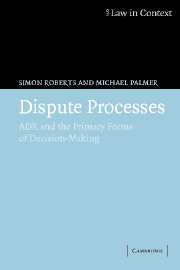Book contents
- Frontmatter
- Contents
- Preface
- Acknowledgements
- 1 Introduction
- 2 Cultures of Decision-making: Precursors to the Emergence of ADR
- 3 The Debates Around Civil Justice and the Movement Towards Procedural Innovation
- 4 Disputes and Dispute Processes
- 5 Negotiations
- 6 Mediation
- 7 Umpiring
- 8 Hybrid Forms and Processual Experimentation
- 9 The Trajectory of Alternative Dispute Resolution
- Bibliography
- Index
9 - The Trajectory of Alternative Dispute Resolution
Published online by Cambridge University Press: 05 June 2012
- Frontmatter
- Contents
- Preface
- Acknowledgements
- 1 Introduction
- 2 Cultures of Decision-making: Precursors to the Emergence of ADR
- 3 The Debates Around Civil Justice and the Movement Towards Procedural Innovation
- 4 Disputes and Dispute Processes
- 5 Negotiations
- 6 Mediation
- 7 Umpiring
- 8 Hybrid Forms and Processual Experimentation
- 9 The Trajectory of Alternative Dispute Resolution
- Bibliography
- Index
Summary
Introduction
In earlier chapters we have charted the progress of what can only be described as a sea change in civil justice arrangements. Visible right across the common law world, there have been corresponding – if less fundamental – reverberations in civilian jurisdictions too. Over two short decades, what appeared in the 1980s as marginal novelties have become established features of the disputing scene. Alternative dispute resolution, with its objective in ‘settlement’ and its principal institutional realisation in ‘mediation’, is now a virtually unremarkable feature of disputing cultures almost anywhere we look.
Looking at these transformations in the most general terms, two preliminary points might be made about them. First, they appear to realise some of the almost apocalyptic forecasts of the early 1980s concerning ‘the changing nature of state power in late capitalism’ (Santos, 1987), the shifting balance between understandings of ‘lifeworld’ and ‘system’ (Habermas, 1981) and the increasing dominance of ‘reflexive law’ (Teubner, 1983). While civil justice has historically presented itself as being fundamentally about the availability of third-party determination, an important ideological shift away from that position has taken place. Here in England, for example, Lord Woolf in his seminal reports on Access to Justice (1995; 1996) characterised the primary objective of civil justice as the sponsorship of settlement, with judgment reduced to the solution of last resort.
- Type
- Chapter
- Information
- Dispute ProcessesADR and the Primary Forms of Decision-Making, pp. 359 - 364Publisher: Cambridge University PressPrint publication year: 2005

